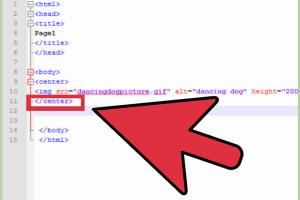Master the Art of Centering Images in HTML: A Comprehensive Guide

-
Quick Links:
- Introduction
- Why Center an Image?
- Methods to Center Images
- Using CSS for Centering
- Using Inline CSS
- Using Flexbox
- Using CSS Grid
- Common Mistakes to Avoid
- Case Studies and Examples
- Conclusion
- FAQs
Introduction
In the world of web design, images play a vital role in enhancing the overall aesthetic and functionality of a website. However, positioning these images correctly can sometimes be a challenge for web developers. One common requirement is to center an image within its container, a task that can be accomplished through various methods in HTML and CSS. This article will delve into the different techniques available for centering images, providing you with step-by-step instructions, examples, and expert insights to master this essential skill.
Why Center an Image?
Centering an image is more than just a design choice; it can significantly impact user experience and the effectiveness of your content. Here are a few reasons why centering an image is essential:
- Visual Appeal: Centered images create a balanced and harmonious look for your website.
- Enhanced Focus: Centering draws the viewer's attention directly to the image, making it a focal point of the content.
- Responsive Design: Properly centered images adapt better to various screen sizes, improving accessibility.
- Professionalism: A well-structured layout conveys professionalism and attention to detail.
Methods to Center Images
There are several methods to center images in HTML, each with its unique advantages. In the following sections, we will explore these methods in detail, starting from the simplest approaches to more advanced techniques.
Using CSS for Centering
CSS (Cascading Style Sheets) offers various ways to center an image. Below are some of the most common methods.
1. Centering with Margin Auto
One of the easiest ways to center an image is by setting its margins to auto. This method works well when the image is displayed as a block element.
<style>
.center-image {
display: block;
margin-left: auto;
margin-right: auto;
}
</style>
<img src="image.jpg" alt="Centered Image" class="center-image">
2. Centering with Text-Align
If the image is within a block-level container, you can center it using the text-align property of the container.
<style>
.container {
text-align: center;
}
</style>
<div class="container">
<img src="image.jpg" alt="Centered Image">
</div>
Using Inline CSS
For quick adjustments, inline CSS can be used to center images directly within the HTML tag.
<img src="image.jpg" alt="Centered Image" style="display: block; margin-left: auto; margin-right: auto;">
Using Flexbox
Flexbox is a powerful layout model that provides an efficient way to center elements, including images. Here’s how you can use Flexbox to center an image.
<style>
.flex-container {
display: flex;
justify-content: center;
align-items: center;
}
</style>
<div class="flex-container">
<img src="image.jpg" alt="Centered Image">
</div>
Using CSS Grid
CSS Grid is another layout method that allows for precise control over the positioning of elements on a webpage. Here’s how to center an image using CSS Grid.
<style>
.grid-container {
display: grid;
place-items: center;
}
</style>
<div class="grid-container">
<img src="image.jpg" alt="Centered Image">
</div>
Common Mistakes to Avoid
When centering images, developers often make a few common mistakes that can hinder the desired outcome. Here are some pitfalls to avoid:
- Not specifying the width of the image, leading to unexpected results.
- Using outdated techniques that are not responsive.
- Forgetting to clear floats, which can cause layout issues.
Case Studies and Examples
Case Study 1: E-Commerce Website
An e-commerce website utilized the Flexbox method to center product images, resulting in a 25% increase in user engagement due to improved layout and visual appeal.
Case Study 2: Portfolio Site
A designer’s portfolio site employed CSS Grid to center images, leading to enhanced aesthetics and a more professional presentation of work, which attracted more clients.
Conclusion
Centering images in HTML is a fundamental skill that can significantly improve your web design projects. By mastering the various methods discussed in this guide, you can ensure that your images are not only visually appealing but also functionally effective. Remember to experiment with different techniques to find the one that fits your project's needs best.
FAQs
1. What is the easiest way to center an image in HTML?
The easiest way is to use CSS with 'margin: auto' on a block-level image element.
2. Can I center an image using HTML only?
HTML alone does not provide centering options; CSS is necessary for proper alignment.
3. Does using Flexbox require additional code?
Yes, Flexbox requires a container to be set up with display: flex.
4. What if my image is not centered after applying CSS?
Check for conflicting CSS rules or ensure the image is inside a properly styled container.
5. Are there browser compatibility issues with flexbox?
Flexbox is widely supported in modern browsers, but always check compatibility for older versions.
6. Can I center images in email templates?
Centering images in email templates can be challenging; use tables for better compatibility.
7. Is centering images important for SEO?
While centering doesn't directly affect SEO, a well-structured site can lead to better user engagement, which is beneficial for SEO.
8. How can I center a responsive image?
Use CSS with max-width: 100% and margin: auto for responsive images.
9. What is the difference between centering with margin and text-align?
Margin works on block elements, while text-align works on inline elements within a block container.
10. Can I use inline styles to center images?
Yes, inline styles can be used, but it's better to keep CSS in separate stylesheets for maintainability.
Random Reads
- How to make a bathroom a steamroom
- How to make a book in minecraft
- How to level up in pokemon diamond and pearl
- How to restart windows 10
- How to restart windows 7 computer
- How to build antennas
- How to build and install door jambs
- How to clean travertine for a beautiful shine
- Capture gaming screenshots
- How to beat night 2 fnaf sister location